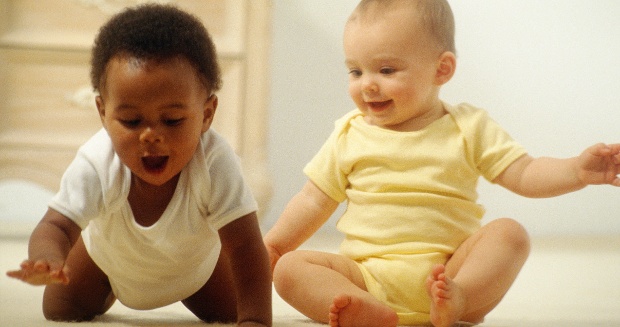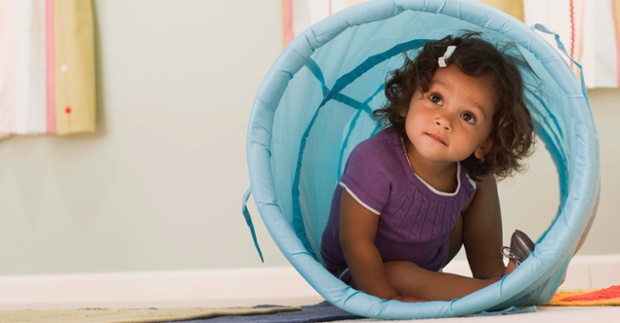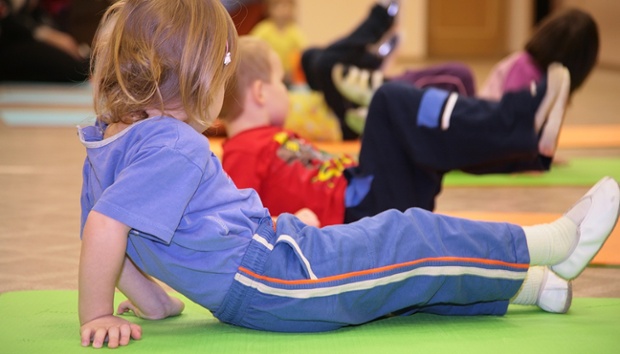How to encourage active play in daycare, preschool
If you work with children 5 years of age and younger, you probably already know that active play is important. But how much active play time do they need each day? What does “physical activity” for this age group look like? And how can you encourage active play if children are reluctant?
Let’s look at the key recommendations for child care providers at specific ages, as well as tips for reaching those recommendations in your daycare center, preschool, or home.

Key recommendations, ages 0-11 months
Infants require supervised tummy time daily while awake, beginning with short periods of 3-5 minutes and increasing time as children show interest and enjoyment. Every day should include planned physical activities that safely support the infant’s developmental milestones, such as head and neck self-support, rolling, floor sitting, kicking, crawling, reaching, and grasping for objects. Large, open, and safe play surfaces should be provided in every infant room as well as age-appropriate equipment that promotes free movement and physical activity.
Tips for meeting recommendations:
- Until an infant is creeping or crawling, provide a cumulative total of at least 30 minutes of tummy time per day. Get down on the floor during tummy time, face to face, so that you can talk, sing, and explore together.
- Encourage exploration by providing rattles, mobiles, and mirrors for young infants; add balls, dolls, simple cause-and-effect toys, and solid furniture (to encourage pulling up) for older infants.
- Place infants on blankets or other safe, dry surfaces with favorite toys nearby to encourage reaching, crawling, and other free movements indoors and outdoors.

recommendations, ages 1-2 years
Toddlers should have at least 60-90 minutes of physical activity per 8 hour day, with opportunities for moderate-to-vigorous activity that gets children breathing deeper and faster than usual. Activities should include outdoor time. Free space, developmentally appropriate toys, and equipment should be available to encourage activity. Variety and fun are important.
Tips for meeting recommendations:
- Model enjoyment of physical activity by joining children in ball play, dancing, games, and other activities.
- Build multiple short periods of physical activity into the schedule—structured gross motor play that includes walking, running, throwing, and kicking, for example, or opportunities for vigorous activity like riding toys, obstacle courses, or jumping.
- Play games that incorporate music, imitation, and simple directions such as animal movements, follow the leader, or dancing with scarves.
- Offer toys that increase spatial awareness and coordination such as push toys (lawn mowers or doll carriages) or pull toys (wagons and riding toys).
- Provide opportunities to jump using mats, pillows, or lines on the floor.
- Provide activities to encourage balance: walking a balance beam or line on the floor, or on different textured or uneven surfaces, with support when appropriate.
- Offer ramps, steps, low climbers, and obstacle courses to build skills, strength, coordination, and confidence.

Key recommendations, ages 3-5 years
Preschoolers require 120 minutes or more of physical activity per 8 hour day, with opportunities for moderate-to-vigorous activity that gets children breathing deeper and faster than usual. At least half of active play should include outdoor time. Free space, developmentally appropriate toys, and equipment should be available to encourage activity. Variety and fun are important.
Tips for meeting recommendations:
- Model enjoyment of physical activity by joining children in ball play, dancing, yoga, stepping, active games, and other fitness activities.
- Build multiple short periods of physical activity into the schedule—structured gross motor play that includes jumping, skipping, and hopping, for example, or opportunities for vigorous activity like riding tricycles, obstacle courses, dancing to music, or playing tag.
- Plan safe, engaging activities outdoors, such as hopscotch, tricycle motocross, freeze tag, or parachute games.
- Development movement stations indoors or outdoors so children can practice developing skills such as throwing, catching, kicking, balancing, changing direction, jumping, hopping, skipping, or galloping.
- Encourage children to work together to create their own games.
- Help children recognize their own faster heart rate and deeper breathing when they are physically active.
At all age levels, you can share information about healthy habits with families through personal conversations, newsletters, and special events.
You might also like:
- 6 Resources for Physical Activity and Learning in Child Care, Preschool
- Physical Activity at Daycare: Help Kids Move More!
- Family Style Meals at Daycare, Preschool Encourage Healthy Eating Habits
Why is physical activity so important? Learn more in our guide, Active Students Achieve More.
Topics: Child Care, Outdoor Activity, Physical Activity
Subscribe for more
Want more ideas for healthy schools, workplaces, child care providers, and families? Subscribe to our blog for weekly tips delivered right to your inbox!
Healthy rewards and incentives for employees NEXT »
Add physical activity to your Thanksgiving celebration
